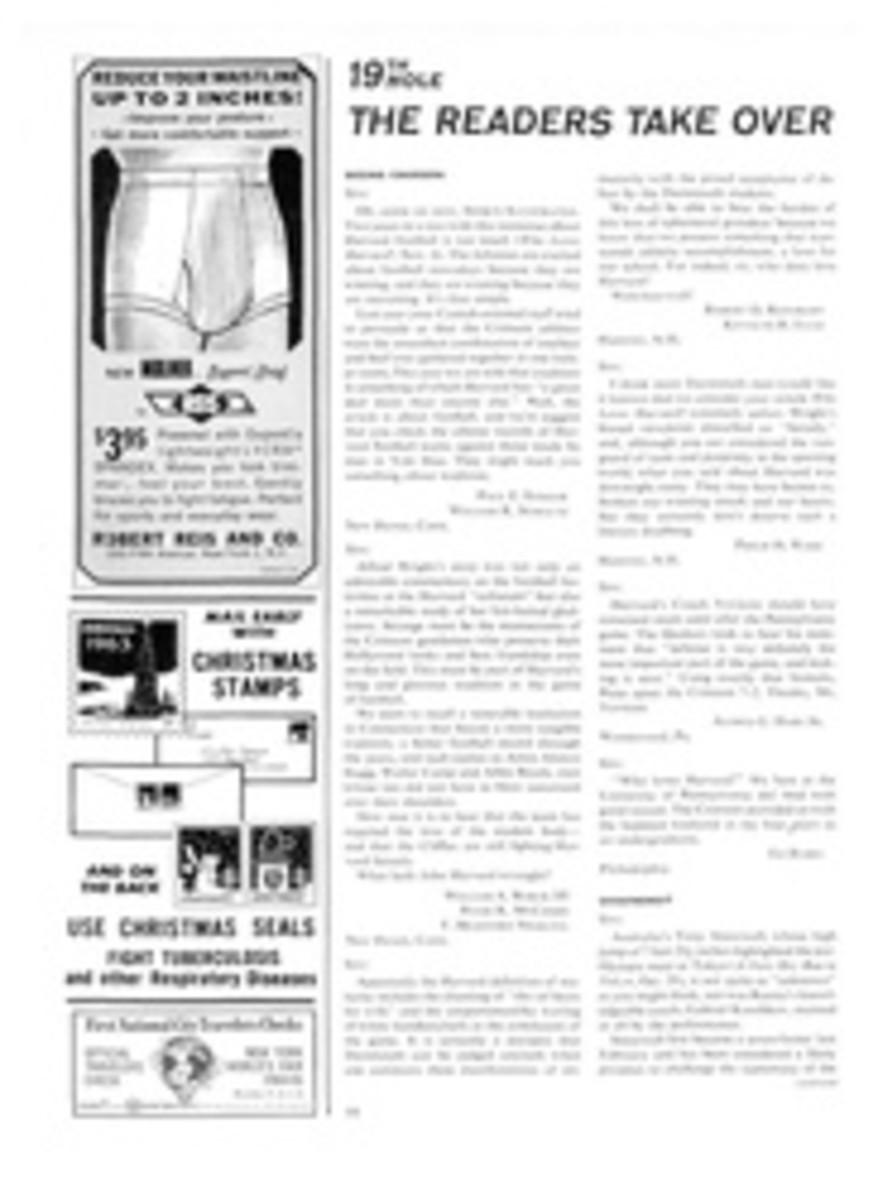
Not poodle, not pointer, but both dogs in one
"The gamekeeper of Nicholson Island, a private shooting preserve off the Canadian shore of Lake Ontario, was demonstrating the versatile talents of a nondescript-looking hunting dog named Komet von der Winterhelle. Staying always within gun range, Komet quartered easily through a millet field for several minutes. Suddenly he broke stride, made a sharp turn upwind and stopped short in a rigid, stylish point. As his master came up from behind, a cock pheasant burst from the grainfield and banked downwind with a frightened cackle. With Komet still on point, the gamekeeper fired and the pheasant fell heavily into the dense briar bordering the field. Komet's master said a few words of praise, then told him to fetch. Shifting instantly from the role of pointer to that of retriever, Komet plunged into the brambles and brought the dead bird back to the man who had produced such artistry by mixing and blending canine ancestry and instincts as carefully as a chemist formulating a new, high-potency rocket fuel.
Gamekeeper Sigbot Winterhelt first exercised his passion for dogs as a boy in Adolph Hitler's Germany. Forbidden to keep a dog of his own, he gave overnight hospitality to an endless series of street mutts smuggled into the house without his parents' knowledge or consent. The dog he was working with such pride on the Nicholson Island millet field a few weeks ago resembled nothing so much as one of those mutts. For Komet is the byproduct of a long line of crossbreeding between English pointers and the now extinct German Wasserpudel. He is not, however, a mongrel, but a member of a breed new to the Western Hemisphere called pudelpointer, whose genealogy has been at least as selective as that of any other breed in the world. About 24 inches high and weighing no more than 60 pounds, the pudelpointer has a tough, wirehaired coat that is surprisingly soft to the touch, a cropped tail, dark-brown eyes, silky ears that are part pointer and part hound, and a comical growth of whiskers that looks like a mustache but is called a 'beard."
As a breed, pudelpointers have been known in Europe for more than 80 years, but the European dogs are far more poodle than pointer, and indeed their hybrid identity has been maintained only by occasional new mixtures of pointer blood. The North American breed of pudelpointer had its beginning in 1956, when Winterhelt, a former secretary of the Pudelpointer Club of Germany, brought a bitch named Cati von der Waldhof to Canada at the suggestion of Douglas Hume, a Toronto businessman. Their purpose was to establish a stable strain of all-purpose hunting dogs, whose traits would reappear generation after generation.
To this end, they mated Cati to a pure English pointer with a long and honorable pedigree. Some of the puppies from this and subsequent matings showed desirable pudelpointer characteristics—good noses, retrieving instinct, wire-haired coats and the breed's curious "beard." Now, after seven years of careful breeding and weeding, Winterhelt and Hume are satisfied that they have a stock of good working dogs.
"It has been a long and expensive proposition, and at times a very discouraging one," says Hume. "Of the 10 dogs we have imported from Germany since 1956, only two have proved good enough to keep in the breeding program. We have had dogs that were as nervous and scared as a caged chipmunk, dogs that couldn't smell and dogs that just wouldn't take to water."
Two notable exceptions are Komet and a bitch named Zenzi von der Waldhorst who, the breeders hope, will become the Adam and Eve of a standardized breed. Says Winterhelt: "We are now in the third generation, and we have 10 pups from the last two litters that look like potential breeding stock. According to Mendel, if the breeding remains the same, dogs should run true to type once the third generation is reached."
Winterhelt is quick to insist that his all-purpose pudelpointer is not "a wonder dog." "It would be foolish," he says, "to think that a pudelpointer could perform in the field with the drive and high-running style of the pointer or retrieve with the power of the Labrador or the Chesapeake. The thing is, the pudelpointer will do both jobs well." Most North American breeders, says Winterhelt, tend to concentrate on the pointing abilities of Continental sporting dogs like the German shorthair, the Weimaraner and the Vizsla, sacrificing the dogs' instinct to retrieve and trail. The pudelpointer can take the scent of a bird from the air, track over ground like a trailing hound and retrieve from both land and water.
In the bag
So completely does Winterhelt instill the importance of retrieving in his dogs that they will, on command, pick up and bring back even live birds. Four years ago Winterhelt arrived at a Toronto field trial with two burlap sacks full of live pheasants in the trunk of his car. One of the sacks had come untied, and when Winterhelt opened the trunk 15 pheasants fluttered out. Fortunately, the birds were dazed by the sudden blinding sunlight and did not get very far. Winterhelt let Komet out of the car and calmly told him to fetch. A pointer handler standing nearby saw Komet dash off after the birds. "He was really horrified," recalls Winterhelt. "He screamed, 'My God, you'll ruin that dog! He'll kill those birds!' But Komet brought every one of those birds back to me unharmed."
As Winterhelt's dogs score impressive wins in field trials, Canadian and American interest in pudelpointers is growing fast. The Canadian Kennel Club has officially recognized the breed, but Winterhelt is a cautious man.
"We are still working with basic breeding stock, and we must be absolutely convinced that we have established a good line before we register the dogs and start selling them."
In the meantime, the fortunate few pudelpointer owners are enjoying their dogs despite the amusement of friends who just can't believe that they are real. Two years ago Douglas Hume flew to New York to deliver a valuable pudelpointer to a friend. A customs officer took a long look and asked, "What the dickens is that?"
Hume told him. "A pudelpointer, huh?" the customs man asked, roaring at his own wit. "Which one was yours, the poodle or the pointer?"
PHOTO
PUDELPOINTER ZENZI VON DER WALDHORST COMES TO A POINT ON A PHEASANT
PHOTO
A YOUNG RELATIVE OF ZENZI'S EAGERLY FETCHES A DEAD DUCK OUT OF A MARSH

